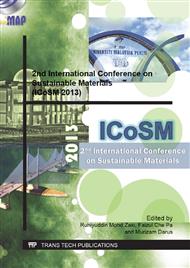p.223
p.228
p.233
p.237
p.241
p.245
p.251
p.256
p.260
The Influences of Cu-Coated SiCp on the Porosity and Thermal Expansion Behavior of Cu-SiCp Composites
Abstract:
The widespread use of metal matrix composites as the packaging materials is due to their tailorable thermal conductivity and coefficient of thermal expansion (CTE). For the same reason, silicon carbide reinforced copper matrix (Cu-SiCp) composites are highly rated as thermal management materials in the electronic packaging applications. However, the Cu-SiCp composites fabricated via the conventional powder metallurgy methods have inferior thermophysical properties due to the presence of porosity in the interface of copper matrix and the SiCp reinforcement. In order to improve the bonding between the two constituents, the SiCp were coated with copper via electroless coating process. Based on the experimental results, the CTE values of the copper coated Cu-SiCp composites were found significantly lower than those of the non-Coated Cu-SiCp composites. The CTEs of the composites tend to decrease as the porosity increases. The significant difference in the CTE values was related to the presence of sub-micron gap between the copper matrix and the SiCp reinforcement.
Info:
Periodical:
Pages:
241-244
Citation:
Online since:
September 2013
Authors:
Price:
Сopyright:
© 2013 Trans Tech Publications Ltd. All Rights Reserved
Share:
Citation:


